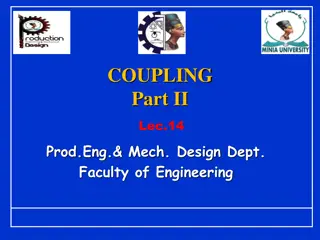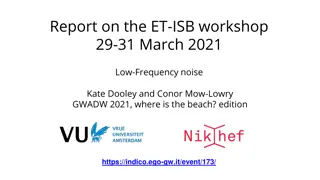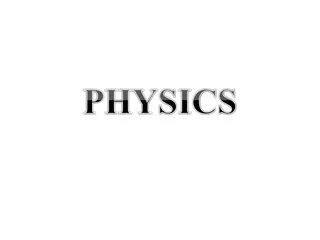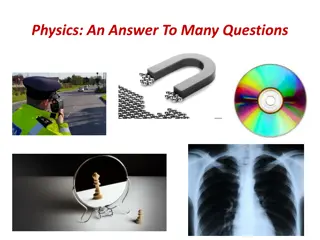Constraints on Top EW Couplings: Workshop on Top Physics at the LC
Workshop on Top Physics at the LC in Paris discussed present and future constraints on top electroweak couplings. The talk indicated how constraints from previous measurements at LEP, Tevatron, and SLC impact realistic expectations. Composite models like Little Higgs play a significant role in top quark predictions. The constraints originate from modifying fermion electroweak couplings, causing UV divergence in Standard Model loops. Various publications and explicit formulas were presented, highlighting the tight constraints on Ztt axial terms and gauge invariance relations.
Download Presentation

Please find below an Image/Link to download the presentation.
The content on the website is provided AS IS for your information and personal use only. It may not be sold, licensed, or shared on other websites without obtaining consent from the author.If you encounter any issues during the download, it is possible that the publisher has removed the file from their server.
You are allowed to download the files provided on this website for personal or commercial use, subject to the condition that they are used lawfully. All files are the property of their respective owners.
The content on the website is provided AS IS for your information and personal use only. It may not be sold, licensed, or shared on other websites without obtaining consent from the author.
E N D
Presentation Transcript
Present and future constraints on top EW couplings Workshop on Top physics at the LC 5-6 March 2014 LPNHE Paris Fran ois Richard LAL/Orsay F. Richard June 2013 1
Introduction In composite models which comprise e.g. extra-dimensions (RS), Little Higgs (LH), one expects a proeminent part for the top quarks Predictions on possible deviations for top EW couplings span a large range from a few %, only visible with ILC, up more to several 10% observable at LHC In this talk, I will indicate how LEP/Tevatron/ SLC constraints already tell us what one can realistically expect to observe F. Richard June 2013 2
A. Juste et al. hep-ph/0601112 A surprising plot F. Richard June 2013 3
Origin of these constraints Recall that if one modifies the fermion EW couplings the SM loops becomes UV divergent and this requires introducing a cutoff ~TeV to compute these contributions Given this cutoff the top EW couplings anomalies are limited by LEP/SLD measurements F. Richard June 2013 4
A. Larios et al. hep-ph/9704288 Explicit formulae 2 2 t 3 2 2 m G ( ) ( ) ( ) 2 2 2 + + + NC R NC L CC L NC R NC L CC L NC R NC L = 2 ln 1e F 2 t m 2 2 1 4 2 t m G ( ) 1 2 + NC L NC L CC L = ln e F 2 t b m 2 2 2 2 W 2 W 4 4 s s g c g c = + + + L= t Z t Z NC L NC R 1 t t L L R R 2 3 2 3 W W g g ( ) ( ) + + + + + b W b W * CC L CC L 1 1 t t L L L L 2 2 If one assumes that charged currents are SM CC =0then at lowest order 1~ NCR NCL~axial term for Ztt F1AZ is tightly constrained F. Richard June 2013 5
A not surprising plot F. Richard June 2013 6
JA Aguilar et al. hep-ph/012037 Gauge invariance Gauge invariance relates ZtLtL to WtLbL and ZbLbL = + NC bL NC tL NC tL CC tLbL 2 From LEP1 we know that ZbLbL has no anomaly meaning that WtLbL WtLbL ZtLtL ZtLtL 0.72 1and b only depend on neutral couplings ZbLbL and ZbRbR Loop contributions therefore fully constrain ZtLtL and ZtRtR and the only freedom left comes from BSM compensating contributions to 1 and b F. Richard June 2013 7
Example of models 30 dgLt/gLt % Wulzeret al 20 Grojeanetal 10 Djouadi etal dgRt/gRt % 0 -90 -70 -50 -30 -10 10 30 50 70 Hosotaniet al -10 Wulzeret al LH -20 Gherghettaet al Pomarol et al -30 -40 F. Richard June 2013 8
Constraints Take | 1/1| and | b/b| <1.5 and =1 TeV A wide range is allowed for dtR/tR while dtL/tL is restricted Most models (after some educated choices ) are consistent with these constraints A few are at the edge meaning that they need a large BSM compensating loop contribution F. Richard June 2013 9
Close up F. Richard June 2013 10
In detail d Ztt/ Ztt % Model dtR/tR % dtL/tL % dtLbL/tLbL % db/b d1/ 1 Carena 0 -330 -20 0 18 0 0 25 -10 -20 -14 0 -14 7 -5 -10 -17 17 -7 0.8 -1.4 0.7 -0.4 -0.4 0.6 1.0 -1.1 0.4 1.1 1.1 2.1 -1.0 -0.8 1.0 1.2 5.8 1.3 -30 70 -36 17 -5 -23 -37 56 -20 Djouadi 0 Gherghetta -20 10 -7 -15 -25 25 -10 Grojean Hosotani Little Higgs Pomarol Wulzer 1 Wulzer 2 F. Richard June 2013 11
Lessons Loop constraints have allowed to trim most of the models (Djouadi and LH had a priori a wide range) Most of the proposed models need large BSM contributions to compensate loop contributions meaning, e.g. for LH, that new particles like heavy vector quarks could be discovered at LHC14 While some of these models could be tested at LHC by measuring single top production or the Ztt production, it will take ILC for a conclusive test of the various scenarios Disentangling of tL and tR is essential to separate models (difficult at LHC) F. Richard June 2013 12
Comparisons Coupling errors ILC LHC 300 fb-1 ZtLtL/ZtLtL 0.6% -66% 15% ZtRtR/ZtRtR 1.4% -100% 148% tLtL/ tLtL 0.24% -7% 12% tRtR/ tRtR 0.24% -7% 12% F. Richard June 2013 13
Conclusions Loop contributions + gauge invariance allows to put very useful restrictions on Wtb and Ztt coupling deviations Some models require large compensating loops which implies light vector quarks Single top and Ztt from LHC still in infancy but in the future could indicate significant deviations The same mechanisms operate for the Higgs sector ILC will be a key instrument to fully elucidate the underlying top and Higgs physics and reach the highest sensitivity F. Richard June 2013 14
Higgs sector The same mechanism is at work when Higgs couplings deviate from SM, compensating contributions are needed to satisfy the LEP/SLC constraints Without these compensations hZZ coupling could not give significant deviations measurable at LHC or even at ILC Quantatively one can write: 3 (1 )log 16 H W M c 2 1(1 12 2 = 2 V = 2 V T )log S 2 2 2 H M with v=1 for the SM case A compensating term dT=0.2 allows to have v=0.7 perfectly measurable at a LC F. Richard June 2013 16
Higgs couplings F. Richard June 2013 17
The RS solution for AFBb Main formulas Can be fully solved with ILC measurements Determining Mkk requires running at 2 energies F(ctR)/F(cbR)~30 close to mt/mb as one would expect in RS Possibly additional terms due to quark mixing 3 4 4 3 2 ' 1 sin 2 dR R M M s M ( ) ( ) ( e ) = + + 1 F c c Q Q Z Z tR tR 2 ' 2 ' 2 KK 0.4 sin cos s Z KK 2 1 dL L M M s M ( ) ( ) ( e ) = + 1 F c c Q Q Z Z tL tL 2 ' 2 KK 0.4 4cos s Z KK dR R s ( ) ( e ) = c Q Q tR s M 2 KK dL L s ( ) ( e ) = c Q Q tL s M 2 KK F. Richard June 2013 18
arXiv:1304.3594 CMS result on ttZ sig/SM=2.04+0.54-0.41 F. Richard June 2013 19
Single top experiment Vtb CDF 0.92+0.10-0.08 D0 1.12+009-0.08 CMS 1.03+-0.12 0.04(th) ATLAS 1.04+.10-0.11 F. Richard June 2013 20























